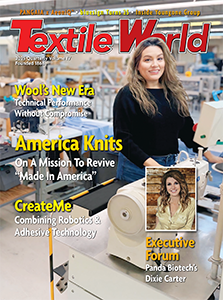 TRENTO, Italy — May 13, 2025 — The New School’s Parsons School of Design, the United Nations International Organization for Migration (IOM), and Aquafil have launched a textile exhibition called “Passage Patterns”, which interprets displacement and migration data through textile design. The Displacement Tracking Matrix (DTM) of the United Nations’ International Organization for Migration, challenged Parsons MFA Textiles students to translate data from DTM’s displacement and migration reports that included histograms, graphs and pie charts, into textiles.
TRENTO, Italy — May 13, 2025 — The New School’s Parsons School of Design, the United Nations International Organization for Migration (IOM), and Aquafil have launched a textile exhibition called “Passage Patterns”, which interprets displacement and migration data through textile design. The Displacement Tracking Matrix (DTM) of the United Nations’ International Organization for Migration, challenged Parsons MFA Textiles students to translate data from DTM’s displacement and migration reports that included histograms, graphs and pie charts, into textiles.
The IOM is part of the United Nations System as the leading intergovernmental organization promoting humane and orderly migration for the benefit of all. DTM is IOM’s primary data collection programme, gathering and analyzing data on the mobility, vulnerabilities, and needs of displaced and migrant populations in over 100 countries to inform context-specific assistance. These innovative textiles made with Aquafil’s ECONYL® regenerated nylon visualize DTM’s data of displacement and migration patterns from different parts of the world.
“In an era where global migration shapes our world’s social fabric, this collaboration stands at the intersection of sustainable design and humanitarian care,” said Preeti Gopinath, associate professor of Textiles at Parsons School of Design. “At Parsons, valuing humanity and the environment through conscious making and innovation, we harness the power of textiles to raise awareness and transform art, industry and society.”
The textiles will be featured at various shows throughout the year to engage audiences in dialogue around migration issues and trends. The first show is in New York at Parsons in May, then the show continues to Chicago where pieces will be featured at Aquafil’s showrooms at both NeoCon and Fulton Market Design Days in June. Finally, the collection heads to the United Nations offices in London and Geneva to reach European stakeholders.
“We are excited to see designers from the Parsons MFA Textiles program bring these displacement and migration stories and data to life,” said Laura Nistri, DTM Global coordinator from the Displacement Tracking Matrix. “Throughout history people have migrated in search of better lives. Addressing displacement is central to confronting today’s global challenges — from conflict and crisis to natural hazards. Safe, dignified migration and mobility are essential parts of the solution. These textile works powerfully capture the human impact of displacement, making it tangible in a way we were proud to showcase.”
Examples of displacement and migration data featured in this textiles exhibition include:
- 2,317,254 people temporarily displaced across 11 districts of Sindh province in 2022 after heavy monsoon rains caused widespread flooring and landslides across Pakistan;
- 55,290 individuals displaced across central and southern Iraq due to climate change and environmental degradation; and
- 57,562 migrants apprehended by the Turkish Coast Guard while attempting to cross the sea to reach the European Union.
“Our team is excited to continue our partnership with Parsons School of Design and the MFA Textiles program for the fourth year in a row to create textiles that are not only sustainable, but create a shared human experience and understanding of one of the most pressing issues of our time–migration,” said Maria Giovanna Sandrini, chief communication officer for Aquafil Group. “We truly value the work that the UN IOM and Parsons are doing to raise awareness about these critical social issues, and that they chose to create these pieces with sustainability in mind.”
Posted: May 13, 2025
Source: Aquafil




